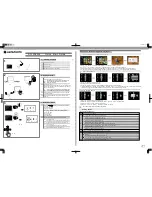
22
TruVision 6MP and 12MP 360° Camera Configuration Manual
To define the PPPoE parameters:
1. From the menu toolbar, click
Configuration
>
Network
>
PPPoE
.
2. Select
Enable PPPoE
to enable this feature.
3. Enter User Name, Password, and Confirm password for PPPoE access.
4. Click
Save
to save changes.
To define the port parameters:
1. From the menu toolbar, click
Configuration
>
Network
>
Port
.
2. Set the HTTP port, RTSP port, HTTPS port and Server port of the camera.
HTTP Port
: The default port number is 80, and it can be changed to any port No.
which is not occupied.
RTSP Port
: The default port number is 554. It can be changed to any port number
in the range from 1 to 65535.
HTTPS Port
: The default port number is 443. It can be changed to any port number
that is not occupied.
Server Port
: The default server port number is 8000. It can be changed to any port
number in the range from 2000 to 65535.
3. Enter the IP address and port if you want to upload the alarm information to the
remote alarm host. Also select the
Notify Alarm Recipient
option in the normal
Linkage of each event page.
4. Click
Save
to save changes.
To set up the NAT parameters:
1. Click
Configuration
>
Network
>
NAT
.
2. Select the
NAT
check box.
3. Select
Port Mapping Mode
to be Auto or Manual. When you choose Manual mode,
you can set the external port as you want.
4. Click
Save
to save changes.
To define the SNMP parameters:
1. From the menu toolbar, click
Configuration
>
Network
>
SNMP
.
2. Select the corresponding version of SNMP: v1 or v2c.
3. Configure the SNMP settings. The configuration of the SNMP software should be
the same as the settings you configure here.
4. Click
Save
to save changes.
Note:
Before setting the SNMP, please download the SNMP software and manage to
receive the camera information via the SNMP port. By setting the Trap Address, the
camera can send the alarm event and exception messages to the surveillance center.
The SNMP version you select should be the same as that of the SNMP software.
















































